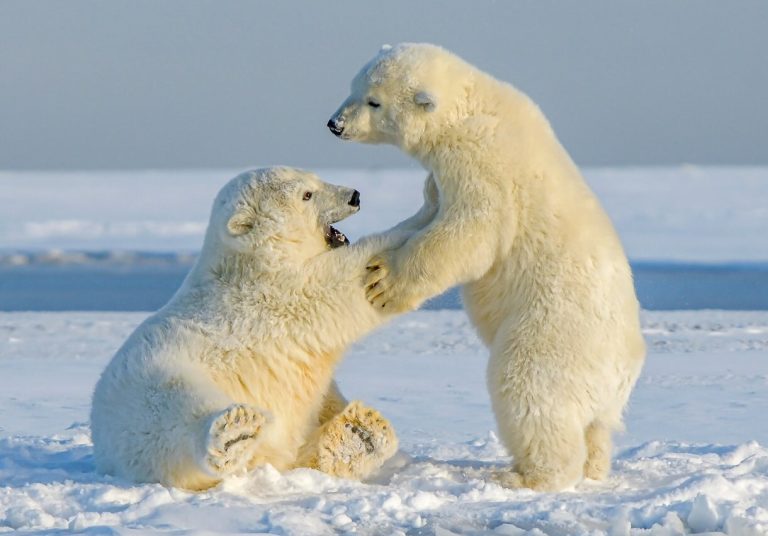
What happened to the polar bears? They used to be all climate activists could talk about, but now they're largely out of the headlines. [emphasis, some links added]
Over the past 20 years, climate activists have advanced various stories of climate catastrophe, only to abandon them quietly and without apology when the evidence to the contrary became overwhelming. The only constant is the scare tactics.
Protesters used to dress up as polar bears. Al Gore's 2006 film “An Inconvenient Truth” depicts a sad cartoon polar bear drifting to its death.
The Washington Post warned in 2004 that the species could face extinctionWWF's chief scientist claims that by 2012, some polar bear populations will be unable to reproduce.
Then in the 2010s, activists stopped talking about them. After years of misinformation, The overwhelming evidence that the global polar bear population has increased dramatically is finally too great to ignore.
Whatever negative impacts climate change brings, they are outweighed by the decline in polar bear hunting. The population has grown from about 12,000 in the 1960s to about 26,000.
Polar bear numbers are increasing
However, it did not fit the climate narrative, so the information was cancelled.
Reality:
Polar bears are being hunted violently
Mass hunting was banned worldwide in 1976
Polar bear population recovers, now at highest level in 6 years
🧵 + References below pic.twitter.com/8HWj3P0GJf
— Bjorn Lomborg (@BjornLomborg) November 27, 2022
The same thing happened with the activist outcry over Australia's Great Barrier Reef. For years they have been chanting that coral reefs are being wiped out by rising sea temperatures.
After cyclones in 2009 caused severe damage to coral reefs, Australian officials estimated that coral reef coverage reached a record low in 2012.
The media is awash with stories of coral reef disasters; Scientists predict that by 2022, coral cover will be reduced by another half. The Guardian even published an obituary in 2014.
The latest official statistics tell a completely different story. In the past three years, The Great Barrier Reef has more coral cover than at any time since records began in 1986, with 2024 set to set a new record.
This good news received only a fraction of the coverage that panic predictions received.
The Great Barrier Reef has never looked better
Annual measurements since 1986 suggest peak in 2024
But you wouldn't know because
1) When conditions get too good, measuring agencies stop publishing reef-wide indices. Instead, their 2024 report released this week is mostly bombastic… pic.twitter.com/zBrEgRKziA
— Bjorn Lomborg (@BjornLomborg) August 9, 2024
Recently, green campaigners have warned that small Pacific islands will be submerged as sea levels rise.
In 2019, United Nations Secretary-General Antonio Guterres flew to Tuvalu in the South Pacific to shoot a cover for Time magazine. Wearing a suit, he stood in thigh-high water with the caption “Our Sinking Planet.”
The accompanying article warned that the island and others like it would be “completely wiped off the map” by rising sea levels.
About a month ago, The New York Times finally shared what it called “surprising” climate news: Almost all atoll islands have remained stable or increasing in size.
Actually, This has been documented in the scientific literature for more than a decade. While rising sea levels do erode land, Extra sand from old coral is washed up on low-lying shores.
Extensive research has long shown that this growth is stronger than climate-induced erosion, meaning the land area of Tuvalu and many other small islands is increasing.
Now, deadly heat waves have become the new climate horror story. In July, President Biden declared that “heat is the number one weather-related killer in the United States.”
Error messages about climate:
News continues to focus on extreme heat
— The world’s smallest temperature risk
Cold kills nearly 30 times more people than heat
(4.6M vs. 0.155M) https://t.co/4k5eU2qzOC https://t.co/MP9iIhN10w https://t.co/eIAeD5EdGi https://t.co/cgafpxqVwC pic.twitter.com/oXLvtR3x0m
— Bjorn Lomborg (@BjornLomborg) August 8, 2024
He was wrong 25 times.
While extreme heat kills nearly 6,000 Americans each year, The cold killed 152,000 people, 12,000 of whom died from extreme cold. Even including deaths from moderate heat, the death toll was less than 10,000.
Despite rising temperatures, The age-standardized number of extreme heat deaths in the United States has declined by nearly 10% per decade, with an even greater decline globally, largely because the world has become more prosperous.
This makes air conditioning and other heat protection technology affordable for more people.
The rigid tone of heat wave coverage illogically distorts policy. Whether it's hot or cold, The smartest way to prevent people from dying from rising temperatures is to ensure cheap, reliable electricity.
This way, it's not just the wealthy who can afford to escape the heat or cold. Unfortunately, many climate policies make affordable energy more difficult to obtain.
Activists have done the world great harm by refusing to acknowledge facts that challenge their deeply pessimistic worldview.
There is good evidence that anthropogenic emissions contribute to climate change, and climate economics generally finds that the costs of these impacts outweigh the benefits.
But the end result was far from catastrophic. The cost of all the extreme policies pushed by activists is far worse.
all in all, Politicians around the world now spend more than $2 trillion per year—far more than the estimated annual cost of these policies to prevent climate change.
Scare tactics leave everyone—especially young people—painful and frustrated. Fear leads to poor policy choices, further frustrating the public. Changing disaster narratives erode public trust.
Telling half-truths while religiously pretending to “follow the science” helps activists fundraise, generates clicks for the media, and helps climate-concerned politicians rally their base.
But this leaves us all under-informed, making the situation worse.
Mr. Lomborg is chairman of the Copenhagen Consensus, a visiting fellow at Stanford University's Hoover Institution, and the author of “Best Things First: The 12 Most Efficient Solutions for the World's Poorest and our Global SDG Promises.”
Popular photo on Unsplash by Hans-Jurgen Mager
Read more in The Wall Street Journal
